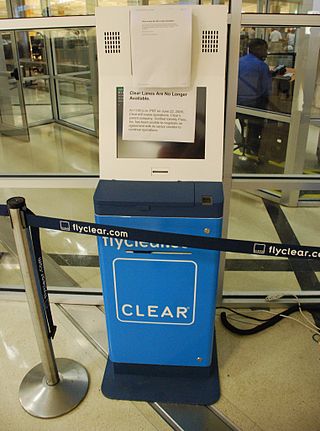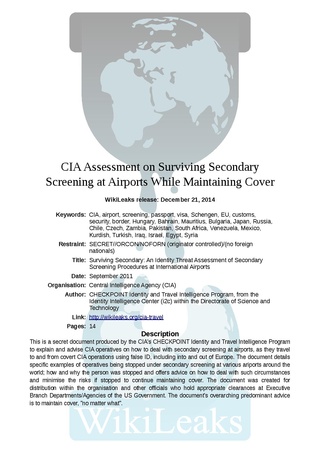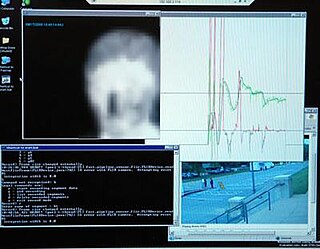Technology and privacy
This section needs additional citations for verification .(May 2021) |
Body screening
Screening Technology has advanced to detect any harmful materials under a traveler's clothes and also detect any harmful materials that may have been consumed internally. Full body scanners or Advanced Imaging Technology (AIT) were introduced to U.S. Airports in 2006. [5] Two types of body screening that are currently being used at all airports internationally are backscatters and millimeter wave scanners. Backscatters use a high-speed yet thin intensity x-ray beam to portray the digital image of an individual's body. [6] [7] Millimeter wave scanners uses the millimeter waves to create a 3-D image based on the energy reflected from the individual's body.
In June 2010, the TSA's commissioners report regulated that screening must follow a framework to ensure fundamental rights and health provisions for travelers. [8] Members of particular groups including disabled people, transgender people, older people, children, women and religious groups have experienced additional negative effects on privacy. On April 15, 2010, a letter from the TSA stated that the TSA had in their possession about 2000 body scanned photos from devices that they claimed were unable to store data/images. [8] [9]
Alternative security measures are offered to travelers who wish to opt out-of-body screening. The United States and European Union allow a traveler the option of refusing screening procedures and instead go through a pat-down. However, if a traveler refuses the pat-down then they are refused entry to the secure area of the airport terminal.
Baggage screening

Baggage screening of all bags entering the airport wasn't implemented until after the 9/11 terrorist attacks. Carry on bags typically go through two stages of inspection: an X-ray screening of the contents in the bag and a manual inspection by a Security Screening Operator (SSO). [10] A manual inspection is only necessary if a SSO has doubts of the contents in the bags. After security checkpoints, carry on bags can be inspected further through random searches and checked in bags are screened for explosives or other dangerous items before being sent out to a passenger's respective flight.
Sniffer dogs/detection dogs
Detection dogs are utilized all over airports specifically in baggage claim sections. The role of a detection dog is to prevent any substance such as illegal drugs or explosives to further enter the facility or leave it. The accuracy and physical capacity of these dogs has raised concerns and has led to the creation of sniffer devices. Similarly to dogs, this device also known as "chemical sniffers" or "electronic noses" is used to detect any trace of drugs and explosives. [11] Odor, although not commonly thought to be connected with an individual's privacy, is unique to every individual. Every individual has a characteristic odor known as the “body odor signature” which can be used to identify gender, sexual orientation, health, diet, and so on. It can reveal emotions like fear and happiness and is viewed as a biological footprint. [11]
In the Lopez Ostra v Spain, the European Court of Human Rights ruled that odor does in fact have an effect on privacy and human rights. [11]
Camera surveillance and the future of facial recognition
Surveillance cameras are placed strategically around airports to ensure the safety of everyone. An increase in camera surveillance then calls for an increase amount of personally stored data. A human machine interface is controlled by a person who operates the surveillance system to assess a situation. The operator is in control of the cameras and determines where the person will appear on the next camera. [12] Facial recognition is an emerging technology measure for airport security. Facial recognition has made its way to camera surveillance. A study done at The Palm Beach airport showed that the false alarm rate of face recognition surveillance was fairly low and had a success rate of almost 50% when it came to matching. [2] The use of facial recognition during the Super Bowl brought up concerns in connection to the Fourth Amendment. [2]
Facial profiling
In 2003, in an effort to improve the detection of terrorist threat, the TSA introduced the Screening Passengers by Observation Technique (SPOT). [13] SPOT is a behavioral recognition system that looks at the way people conduct themselves through facial expressions and body movement. TSA Behavior Detection Officers (TBO) are stationed at airport security checkpoints and keep an eye out for behavior from travelers that may give off any suspicion of malice. [13] SPOT has been highly critiqued for the times it has been used to misidentify a threat causing intrusive searches on travelers based on a hunch that a TSA official has. [13]

Biometric systems
Biometrics are human characteristics that are unique to every individual and that usually do not change such as fingerprints, speech, face, etc. [14] Electronic gates, also known as e-gates, have become very common in airports because of their ability to verify travelers based on their biometric information. There are two types of privacy concerns when discussing e-gates, one is general privacy and the other is system-specific privacy. System-specific privacy focuses on beliefs regarding the capability of the system to protect privacy. Europe is the first to have introduced e-gates in their airport facilities, and the future of airport technology for the United States points toward e-gates.
In the United States, there are two registered travel programs: the Register Travel (RT) system and the Global Entry (GE) System. These programs are designed to expedite immigration procedures for trusted travelers and are primarily based on fingerprint recognition. [15]









